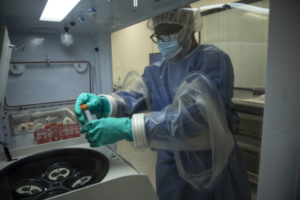The Rise of Point-of-Care Cell Manufacturing
Decentralized approach represents a paradigm shift in the way Canada studies, commercializes and delivers stem cell treatments for serious diseases
 Long before institutionalized and standardized medicine fundamentally changed the provision of healthcare delivery in the 19th century, nearly everything about it was local. Knowledge and “remedies”, such as they were, were the sole domain of your nearby apothecary. Of course, an explosion of research made way for a medical system rooted in evidence, as well as standardized treatments and technologies, we know today.
Long before institutionalized and standardized medicine fundamentally changed the provision of healthcare delivery in the 19th century, nearly everything about it was local. Knowledge and “remedies”, such as they were, were the sole domain of your nearby apothecary. Of course, an explosion of research made way for a medical system rooted in evidence, as well as standardized treatments and technologies, we know today.
However, when it comes to manufacturing and delivering certain stem cell therapies for both clinical trials and treating patients, individualized, localized delivery may once again become the norm. This may be especially true for cell products created using an individual’s own cells (autologous stem cells), for which smaller numbers need to be manipulated and returned to the patient to treat their disease. Emerging point-of-care technologies may make the process faster and available to larger numbers of patients across the country, while accommodating smaller batch requirements and expanding manufacturing capacity.
“There is a role for both point-of-care and centralized cell manufacturing” says Dr. Duncan Stewart, Scientific Director of the Ontario Institute for Regenerative Medicine and CEO and Scientific Director of the Ottawa Hospital Research Institute. “Big-box manufacturing has the edge when scaling up to make large batches of off-the-shelf cell therapies derived from unrelated donor cells, for example. But point-of-care has important advantages when we are providing individualized treatment for patients.”
“The challenges with point-of-care are about delivering safe cell therapies that meet Current Good Manufacturing Practices (cGMP) and other standards for reproducibility and reliability – very small changes in a manufacturing process can make significant differences in the end product,” Dr. Stewart continues. “Where the field is heading, I think, is toward using closed systems and partially automated approaches that take variability out of the equation, so we get a high-quality product every time. We’re seeing a lot of advancements in these technologies.”
The Biotherapeutics Manufacturing Centre (BMC) at The Ottawa Hospital is a good example of a point-of-care manufacturing. It’s a world-class facility, one of only a handful in Canada capable of developing, assessing and manufacturing viral-, antibody- and cell-based therapies in accordance with cGMP and other quality, safety and compliance standards. It combines the latest technology with clean room facilities and highly trained personnel to create an accelerator program capable of navigating everything from preclinical research through clinical trial design and the regulatory pathway. BMC works with several universities and biotech firms to bring novel therapies through the clinical trial process, and to treat patients at The Ottawa Hospital.
Dr. David Courtman, Director, Cell Manufacturing for BMC, notes that point-of-care cell production may have several therapeutic advantages over centralized approaches.
“When cell therapies are scaled up in a centralized facility, it will typically involve a cryopreserved product that is shipped to a hospital, thawed at the bedside and injected,” he explains. “There are big challenges with preserving the functional and therapeutic capacity of frozen cell products. And when you have a new technology, what trumps everything is therapeutic index – if you don’t have good efficacy, your clinical the trials won’t move forward, because there is so much variability to begin with.”
Dr. Courtman notes that, while the concept of point-of-care autologous cell therapies is not new – bone marrow transplants using a patient’s own cells have been performed in several hospitals for decades –newer cell-based treatments will be more complicated.
“Bone marrow transplants are phenomenal from the point of view you that you can remove the patient’s stem cells, treat the cancer and return the cells in a single injection,” he says. “Many of the successful new therapies we are seeing in clinical trials are likely going to involve multiple injections over a period of months. That means that using a mismatched allogenic product is not optimal, but accessing a patient’s cells, manipulating them and returning them at the bedside will be. Plus, there is a huge immunological advantage when we use autologous cells.”
Many unanswered questions remain to be addressed before point-of-care cell therapeutics become an everyday aspect of our healthcare system . Among them, the cost of delivering point-of-care cell therapy is often at the forefront of debates about its potential versus centralized production. After all, for well over a century, centralized manufacturing paradigms have created cost and production efficiencies that have allowed for mass production of everything from cars to clothing to pharmaceuticals. However, both Dr. Courtman and Dr. Stewart stress that, without appropriate strategic investment, Canada won’t realize the potential value of point-of-care approaches in treating disease.
“New technology is often costly, and early adoption will not really save us money in our healthcare system,” Dr. Courtman concludes. “But think of it this way – if we still did heart transplants the way the very first one was performed, we would not be doing any today because of the resources that were required. As technologies mature, costs tend to go down while efficacy goes up because we only stick with what we have shown to work.”
Click here to read about how point of care technology is advancing cancer research and treatment in Canada.
Photo: The Ottawa Hospital
